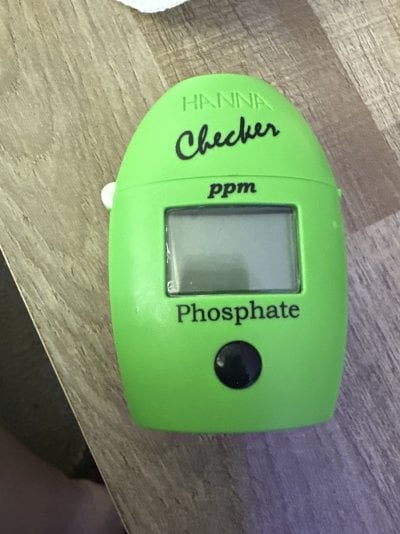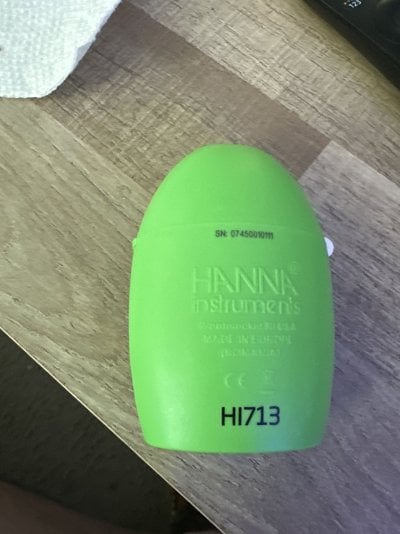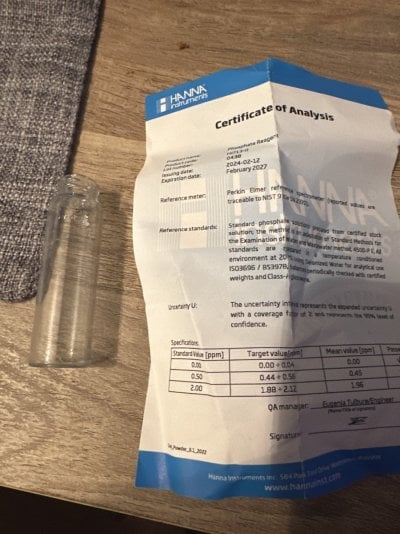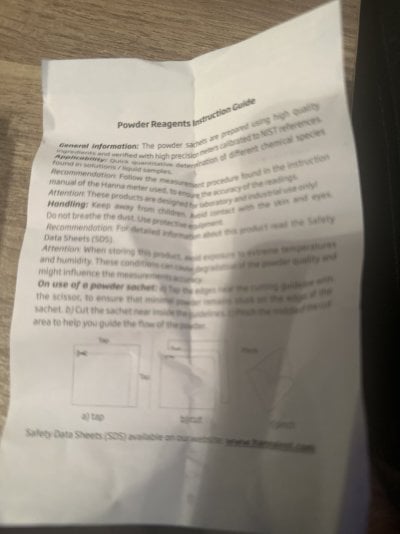I bought this and find all the lines are not only inconsistent, but they also are not 10ml


Navigation
Install the app
How to install the app on iOS
Follow along with the video below to see how to install our site as a web app on your home screen.
Note: This feature may not be available in some browsers.
More options
You are using an out of date browser. It may not display this or other websites correctly.
You should upgrade or use an alternative browser.
You should upgrade or use an alternative browser.
phospate changes
- Thread starter Ballyhoo
- Start date
- Tagged users None
Yeah, I had this happen before, that auto shut off feature is really annoying, I wish it was a simple on off switch, but I guess they want to make sure no one leaves it turned on accidentally and drain the battery.It took me while to nail it down but now I have routine that I follow so it's not too bad. It goes smooth unless my Gal comes in and starts asking questions and the PO4 tester times out before I see the results. I don't know why Hanna has that tester auto shut off so much sooner than the NO3 and alk testers.
When this happens I simply retest with the same sample, but instead of holding to start the timer for the second stage, I just do a normal press and it’ll immediately process the result. If you aren’t using 2 vials you’ll have to fill a new one for the first stage of course.
this is the one I have.
Totally different subject, I'm also thinking about buying a par meter maybe I should start a different thread, but could I get a good one for $300 or less?
I don't think I have enough par in my aquarium. every day I increase it a little.
finally after four months I can say my softies at least are all doing OK, though there has been a lot of past mortality. No luck with SPS. stupidly as a noob I purchased a lot of SPS achros , etc. I think out of ten I bought I have one that's living.
also, I know people have talked about renting meters, but I don't like that idea. I would like to own one because I mean in the future I might want to rearrange things change things. I don't wanna have to rent it again plus maybe I'll get another tank sometime in the future.


Totally different subject, I'm also thinking about buying a par meter maybe I should start a different thread, but could I get a good one for $300 or less?
I don't think I have enough par in my aquarium. every day I increase it a little.
finally after four months I can say my softies at least are all doing OK, though there has been a lot of past mortality. No luck with SPS. stupidly as a noob I purchased a lot of SPS achros , etc. I think out of ten I bought I have one that's living.
also, I know people have talked about renting meters, but I don't like that idea. I would like to own one because I mean in the future I might want to rearrange things change things. I don't wanna have to rent it again plus maybe I'll get another tank sometime in the future.


Last edited:
actually on the par meter I'm gonna do a different thread and ask. This one looks good, but IDK.

 www.bulkreefsupply.com
www.bulkreefsupply.com

MQ-210X Original Underwater Quantum PAR Meter
The MQ-210X quantum meter is designed for underwater PAR measurements and already applies the sensor's immersion effect correction factor to the meter readings through firmware. The meter is excellent for all light sources, except LEDs, where post-measurement correction factors need to be...
Can you post a pic of the instructions ? I am wondering if they are revised and different than minethis is the one I have.
Totally different subject, I'm also thinking about buying a par meter maybe I should start a different thread, but could I get a good one for $300 or less?
I don't think I have enough par in my aquarium. every day I increase it a little.
finally after four months I can say my softies at least are all doing OK, though there has been a lot of past mortality. No luck with SPS. stupidly as a noob I purchased a lot of SPS achros , etc. I think out of ten I bought I have one that's living.
also, I know people have talked about renting meters, but I don't like that idea. I would like to own one because I mean in the future I might want to rearrange things change things. I don't wanna have to rent it again plus maybe I'll get another tank sometime in the future.


IdkCan you post a pic of the instructions ? I am wondering if they are revised and different than mine
I seem to have misplaced the actual instructions, but I definitely remember them very distinctly. You fill up each cuvette to the level designated on the cuvVet, with the lines now actually becoming faint. You put control cuvete into tester and press until it says reads C1, you remove, ad reagent to sample cuvette then shake for 90 seconds , place in tester, press tetser until it reads C2, it then it counts down from three minutes and gives you the value. It comes with a micro cloth you're supposed to clean both cuvettes. the YouTube video I watched that shows you how to do it. I actually add the reagent and shake the sample before I start the whole process because if you wait too long bw c1 and v2 the tester will reset. The YouTube video the guy says you don't have to shake reagent for 90 seconds but Just wait till the reagent disintegrates. But I pretty much shake it until 90 seconds. instructions indicate to shake gently.


when you turn it on there should be nothing inside it. When it says add c1 that’s when you add your water sample, hit the button, and it’s zeroing against your sample. When it says add c2 that’s when it’s doing the actual test with the reagent added to the sample. The second cuvette is a spare / backup
here’s the official current instructions from their website. Maybe I’m missing it. Looks pretty clear that one curvette is to be used


here’s the official current instructions from their website. Maybe I’m missing it. Looks pretty clear that one curvette is to be used
Last edited:
these instructions do vary and I have to find my original instructions, but I also was shown at LFS. Would it make a difference if you had a second Cuvette with reagent already ready to go so you don't have to hurry in between the interval between C1 and C2? I think that was the point of the second cuvete is that once you do C1 you have a certain amount of time to get ready and stir reagent and add for C2 before the hanna resets. idk im going to tear things down to find the instructions i have somehow got separated from kit.
It can make a difference. Hanna PO4 is a colorimeter. It works by measuring the amount of light reflects back through the filter to basically read the color of the sample. Anything like smudges on the curvette, debris or other particles like pods in your sample will affect the test to some degree. Imperfections in the curvette can cause some alteration. It is generally better to calibrate zero with the same water you will add the reagent to because particles will vary from one 10cc syringe to another more than you might think.these instructions do vary and I have to find my original instructions, but I also was shown at LFS. Would it make a difference if you had a second Cuvette with reagent already ready to go so you don't have to hurry in between the interval between C1 and C2? I think that was the point of the second cuvete is that once you do C1 you have a certain amount of time to get ready and stir reagent and add for C2 before the hanna resets. idk im going to tear things down to find the instructions i have somehow got separated from kit.
Randy Holmes-Farley
Reef Chemist
View Badges
Staff member
Super Moderator
Excellence Award
Expert Contributor
Article Contributor
R2R Research
My Tank Thread
It works by measuring the amount of light reflects back through the filter to basically read the color of the sample
Do you literally mean reflects back? I always through it was a single pass absorbance measuring device, but I've never looked inside one.
The point of the second curvette is that it is a backup / sparethese instructions do vary and I have to find my original instructions, but I also was shown at LFS. Would it make a difference if you had a second Cuvette with reagent already ready to go so you don't have to hurry in between the interval between C1 and C2? I think that was the point of the second cuvete is that once you do C1 you have a certain amount of time to get ready and stir reagent and add for C2 before the hanna resets. idk im going to tear things down to find the instructions i have somehow got separated from kit.
Just have the reagent pack cut open, folded in a funnel, and ready to go before you start the test
passes through the filter(s). I’ve never opened one either. LolDo you literally mean reflects back? I always through it was a single pass absorbance measuring device, but I've never looked inside one.
.15 is fine for phosphate. Do you mean .2 or 1.2?aiming for < .09 but it's been from .15 to 1.2. all over the place.
- Joined
- Sep 21, 2018
- Messages
- 7,571
- Reaction score
- 7,962
Have peered inside and @taricha (of course) has opened one up. LED on one side, detector on the opposite side. Light path might be a bit complicated because of the curved glass of the vial. This we figured out when we tried replacing the vial with a typical 1 cm cuvette.Do you literally mean reflects back? I always through it was a single pass absorbance measuring device, but I've never looked inside one.
I believe the Hanna instructions specifically say to may sure the sample is particle free. I would take extra time/different collection method to ensure it's always particle free. Maybe collect in a different area.well, I remember seeing particles in the turkey baster last time I got my sample, but I couldn't get them out so I have like these floating particles in the tank. I don't know what they are if it was food, sand somehow floating around in the tank, but it just seems more like detritus.
- Joined
- May 22, 2016
- Messages
- 6,970
- Reaction score
- 10,747
Yep it's a straight through, also the detector is not specific at all. It'll measure any light color and output a voltage. The LED on the other side provides all the wavelength selection.Have peered inside and @taricha (of course) has opened one up. LED on one side, detector on the opposite side. Light path might be a bit complicated because of the curved glass of the vial.
My profile pic is actually a photo of what happens to the light that shines from an LED into the cuvette, it's focused by the curvature and so more light hits the detector on the other side than if it was a flat, square cuvette.
Similar threads
- Replies
- 8
- Views
- 267
- Replies
- 17
- Views
- 291
- Replies
- 38
- Views
- 1,235
- Replies
- 9
- Views
- 71


















